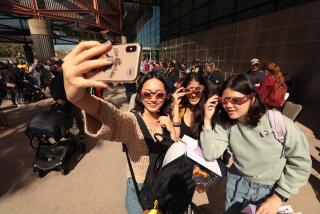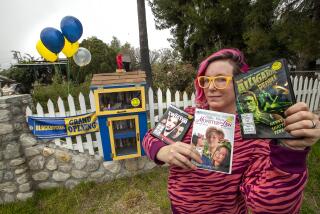Glasses-free 3-D gadgets begin rollout
The big problem with 3-D TV, which has been a flop so far despite huge hype, is the glasses. Making sure everyone in the room has a pair to view a show can be expensive and impractical, not to mention socially awkward.
But 3-D could be on the verge of a revolution that leaves the eyewear behind. A new generation of glasses-free 3-D gadgets have begun to roll out:
•A Nintendo video game console that shows 3-D without glasses arrived in the U.S. last month and is already a hit.
•Two smart phones — from LG and HTC — with non-glasses, 3-D screens are due out by the end of the year.
•And in Japan, Toshiba has two glasses-free 3-D TV models on the market, with plans to bring the technology to the U.S. in 2012. Meanwhile, Panasonic and Sony are working on sets of their own.
The glasses-free technology is far from perfect, at this stage. It works best on small screens, with viewing in some cases restricted to one person at a time. But it’s developing to the point where some analysts believe it could eventually make non-glasses 3-D TV practical for the home.
If it doesn’t, 3-D TV could go the way of quadraphonic sound and other tech developments that never caught on with the public.
“Using glasses was always an interim step,” said Michael Gartenberg, research director at Gartner Inc. “For normal consumers, it’s got to be glasses-free. The technology must advance to where that’s not required.”
Even a 3-D evangelist as fervent as movie director James Cameron — whose “Avatar,” filmed in 3-D, is the highest grossing film of all time — said the glasses have to go in order for the technology to succeed in homes.
“High-quality, full HD-resolution large screens that have multiple viewing angles that don’t have glasses at all,” Cameron said in talking about 3-D TV in a keynote address at the National Assn. of Broadcasters show earlier this month. “That is the point where the curve is going to go ballistic.”
Viewing flat, 2-D pictures as if they existed in 3-D has generally required a device to blend offset images (one for each eye) to produce the illusion of depth. With movies, the blending was done by the glasses audience members wore.
The first 3-D movie craze was in the 1950s, and there have been advances since then to boost quality. But consumers are still stuck with wearing the specs, whether in theaters or at home watching one of the 3-D enabled televisions that hit the market last year.
Aside from the glasses, analysts have blamed disappointing sales of 3-D TVs on their premium prices. But reductions in those prices over time have not had a major effect.
“Glasses are becoming a more prominent inhibitor,” said analyst Ross Rubin of the NPD group in a study released earlier this month, “and are poised to overtake price.”
Glasses-free 3-D technology, which has been in development for decades, usually aims to embed the viewing regimen into the screen. In some cases, the tiny pixels meant for the left eye are electronically masked so they won’t be seen by the right eye, and vice versa.
But whatever regimen is used, it’s a tricky, imperfect process.
Reviewers of the new Nintendo 3DS handheld game console, which has a 3.53-inch screen (about the same size as on an iPhone), said that the device had to be held almost perfectly still to keep the 3-D effect sharp. Viewing at an angle could bring on not only a skewed view, but also a headache.
Nonetheless, on the day the $250 player was released in the U.S., it set a Nintendo record for the most handheld consoles sold by the company in a day.
A prototype of the upcoming LG smartphone had a 4.3-inch screen for showing 3-D games and YouTube clips, as well as 2-D content. “The idea is that 3-D is an accessory for the phone, but not the only reason to buy the phone,” said LG marketing specialist Martin Valdez.
In a recent demonstration, the 3-D images on the smartphone were sharp, but like on the game console, only if the unit was held steady and not at an angle.
The phone was also equipped with a camera that could take homemade, 3-D video clips. But these clips, when shown on the phone screen, were particularly blurry and viewing them brought on some queasiness.
Valdez said that LG was working to remedy the image problems before the phone is released.
The glasses-free, Toshiba 3-D TVs available in Japan take a major step forward in that they were meant to be seen by groups of people, not just a lone viewer. And the sets have received good reviews for sharpness. But there’s a catch — they have to be viewed from one of nine designated angles to get the proper 3-D effect.
Another drawback — the two Toshiba models are relatively small. They come in 12- and 20-inch screen sizes. Paul Gagnon, a television analyst at DisplaySearch, said the small sizes would likely not do well in the U.S.
“People are used to big TVs,” he said. “If they had a choice to stick with their high-definition flat panel or spend thousands on a tiny set, very few will choose the second.”
The vice president of Toshiba’s digital products division in the U.S., Jeff Barney, said in an email that the sets for the U.S. market will be larger.
A company based in New York, 3DFusion, has been working on the viewing angle problem. Its prototypes, like the Toshiba models, have nine sweet spot viewing angles for optimal quality. But the company uses technology that melds images from one sweet spot to the next, allowing viewers in the in-between areas to get a watchable picture.
“Very few people are going to buy a TV where you have to stay in one spot or can’t go to the bathroom and look at the screen without getting dizzy,” said company president Steve Blumenthal. “It’s a nonstarter.”
If non-glasses 3-D TV becomes more practical for the home, there could be an upcoming generation ready to embrace it.
On the day the Nintendo’s 3-D game machine went on sale, Miguel Claros, 12, stood in the middle of a Toys R Us store in Culver City, clutching a freshly purchased console to his chest.
The seventh grader had studied hard and behaved well in preparation for the moment.
“I got all A’s and B’s to earn this from my dad,” he beamed. “It’s totally different and better than all the other stuff out there.”







